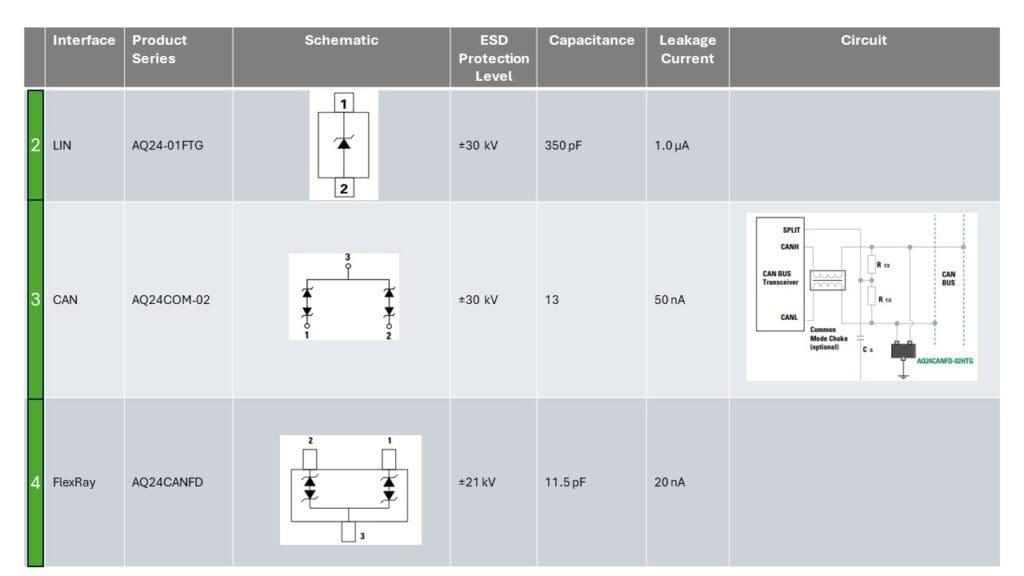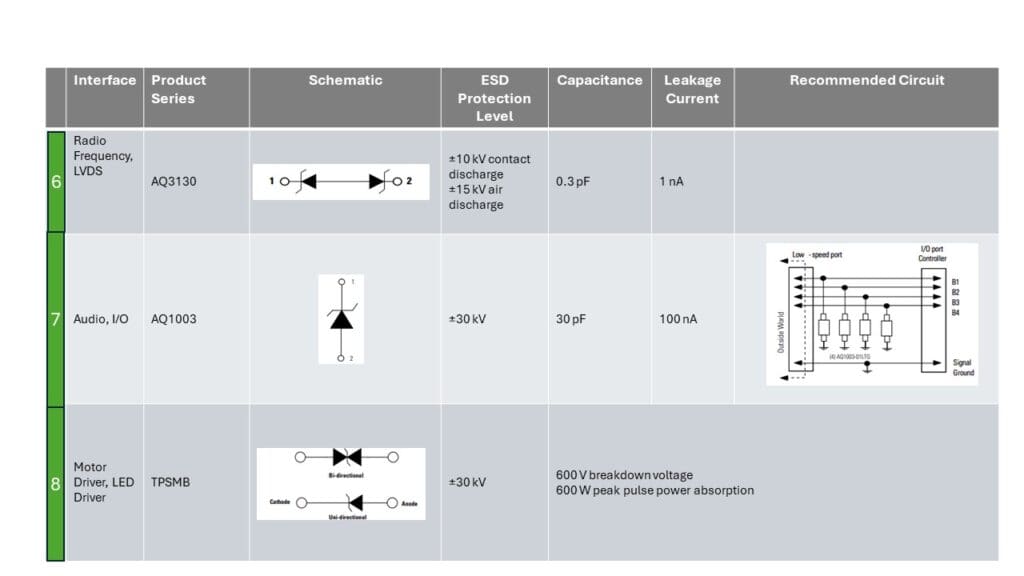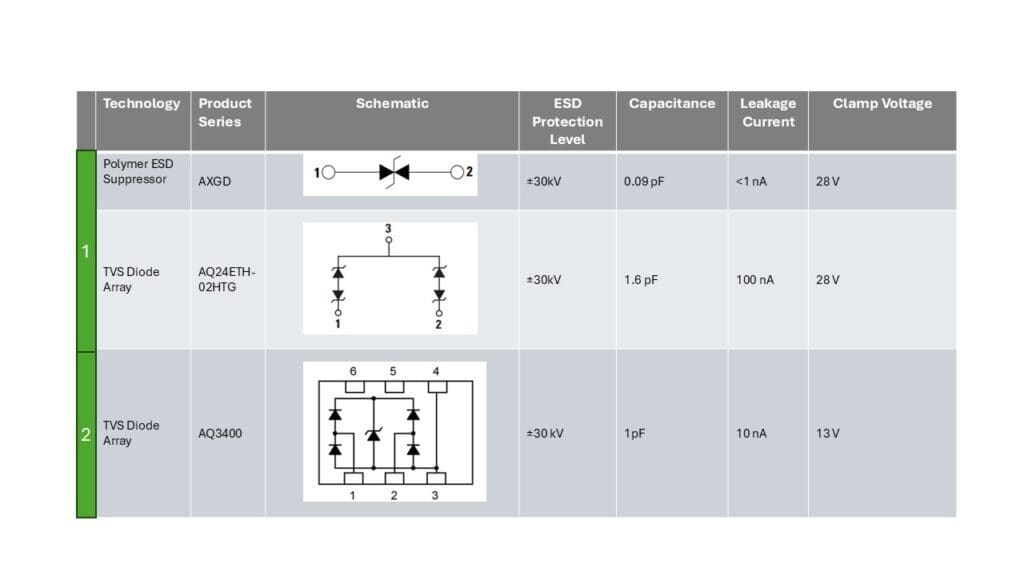
Sponsored by Littelfuse, Inc.
Guaranteeing circuit survival within the difficult automotive and electrical car environments.
As car electrification grows and provides capabilities, the digital management structure should evolve to handle operations effectively, responsively, and safely. The structure is shifting from a easy distributed system to a zonal management system, the place zonal management items handle close by ECUs, simplifying wiring and lowering car weight. Automotive Ethernet is the primary protocol for zonal management.
The zonal management unit is essential for your entire car, requiring sturdy safety towards overcurrent, transient voltages, and ESD. Defending Ethernet traces ensures dependable communication and information integrity. This text guides designers in choosing elements to safeguard zonal controller circuits and communication traces, enhancing automotive electronics‘ reliability.
The evolution of automotive management architectures
Automotive architectures should adapt as car electrification grows. Excessive-end autos might now have as much as 150 ECUs, with options like autonomous driving including extra complexity. The rising variety of ECUs strains the distributed management structure, the place every ECU communicates by way of a central gateway, creating bottlenecks.

To ease these calls for, a website construction was developed, grouping widespread capabilities like powertrain and lighting underneath area controllers. Nevertheless, this will complicate wiring because of the distance between capabilities.
The superior zonal management construction makes use of zonal management items to handle capabilities inside particular car zones, enabling extra software-defined performance. Zonal management gives a number of advantages:
- Reduces wiring complexity and complete wiring.
- Enhances modularity and scalability, permitting adjustments with out affecting your entire car.
- Permits sooner, extra environment friendly coordination via high-speed Ethernet.
- Improves response occasions, vitality effectivity, and security with distributed processing energy.
Zonal management items should stand up to electrical hazards like overcurrent, overvoltage transients, and ESD to stay operational. Including acceptable safety elements to the circuitry ensures sturdy efficiency.
Zonal Management Unit (ZCU) Description
The ZCU interfaces with all varieties of gadgets in its zone of management. Thus, it could possibly use many various kinds of communication protocols to interface with a variety of gadgets. Determine 2 illustrates the circuit blocks of a ZCU. Hazards that might injury the ZCU embody overcurrent circumstances, transient voltages, and notably ESD.

Defending the DC/DC Converter
The DC/DC Converter down-converts the 12 V enter to digital logic voltage ranges. For the reason that DC/DC Converter is the facility entrant to the ZCU, stopping injury from an overcurrent situation and preserving voltage transients out of the circuit is important for dependable operation.
Both a one-time fuse or a resettable fuse can present overcurrent safety. Think about a fast-acting, one-time fuse. Variations can open in lower than 5 s to a 250% overload. A large temperature vary is important for automotive functions. Fuses rated from -55° C to +150°C can be found. To avoid wasting area, choose a floor mount fuse, which could be in a small 1206 package deal. Additionally, select AEC-Q200-qualified elements for automotive functions each time doable.
A polymer optimistic temperature coefficient (PPTC) resettable fuse is an alternative choice to the one-time fuse. A profit over a single-shot fuse is that PPTCs are resettable. As soon as the overcurrent situation has cleared, the PPTC will return to a low-resistance state and reconnect the facility to the circuit. AEC-Q200 variations can be found and are available in space-saving surface-mount packages.
For voltage transient safety, notably towards inductive transients reminiscent of inductive vitality discharges, both a metallic oxide varistor (MOV) or a transient suppressor diode (TVS) can safely take in their vitality. MOVs:
- Can take in load dump vitality as much as 25 J as required by SAE specification J1113
- Have a large working temperature vary from -40° C to +125° C
- Are AEC-Q200 compliant.
The choice part, fashions of TVS diodes, supply:
- ESD safety to strikes as massive as 30 kV in accordance with IEC 61000-4-2
- Absorption of peak energy pulses as much as 1500 W or surge currents as much as 200 A
- Response occasions from underneath 1 ps to underneath 1 ns
- A large working temperature vary of -65° C to + 150° C
- Uni-directional or bi-directional fashions
- Floor mount packaging
- AEC-Q101 qualification.
Defending the DC/DC Converter from overcurrent and transient voltage surges prevents these hazardous circumstances from propagating to downstream circuits, making certain the ZCU processor is shielded from damaging vitality.
Defending the ZCU interface circuits
Within the high-noise, high-transient automotive surroundings, ZCU circuits interfacing with exterior gadgets by way of communication protocols or management drivers require ESD safety. Littelfuse gives a broad vary of ESD diodes and polymer elements tailor-made to totally different protocols, optimizing sign integrity whereas offering sturdy safety. Tables 1 and a couple of suggest ESD diodes for numerous interfaces, with schematics displaying configurations. For RF circuits, the advisable ESD diode has the bottom capacitance and leakage present, minimizing sign distortion. Instance circuits illustrate TVS diode implementation for CAN and I/O interfaces.


Defending the Automotive Ethernet bodily layer, the spine of zonal structure
Automotive Ethernet is now the primary communication interface in zonal management architectures as a consequence of its excessive information transmission charges, reaching as much as 10 Gb/s—far exceeding different automotive protocols. Present charges are usually 100 Mb/s and 1 Gb/s. Ethernet’s light-weight, two-wire twisted pair, sturdy error-checking, and scalability make it preferrred for the tough automotive surroundings and future necessities.
The push for Ethernet in zonal structure comes from the OPEN Alliance SIG, a non-profit group of automotive and tech suppliers selling Ethernet as the usual for automotive networking. The highest desk in Determine 3 lists numerous “flavors” outlined by the alliance, whereas the decrease desk compares automotive Ethernet with CAN and LIN protocols.

The OPEN Alliance has outlined particular necessities for safeguarding automotive Ethernet circuitry from ESD. Determine 4 reveals an Ethernet transceiver circuit with the ESD safety machine’s advisable location referred to as “1”. The adjoining desk lists the OPEN Alliance’s necessities for an ESD suppression machine. (The ESD safety “2” has no relation to the OPEN Alliance SIG.)

Littelfuse has developed quite a few ESD suppression elements for Ethernet safety, together with one which particularly complies with the OPEN Alliance necessities. Along with assembly the necessities of the OPEN Alliance for an ESD suppression machine, the Littelfuse resolution has low capacitance to reduce distortion of the Ethernet alerts and low leakage to reduce vitality consumption. Desk 4 accommodates particulars on three choices for Ethernet safety. The Polymer ESD suppressor has the benefit of the bottom capacitance and the bottom leakage present. The 2 TVS diode arrays shield two information traces in a single package deal. All three elements exceed the advisable ESD safety stage referred to as out by the OPEN Alliance SIG. They’re all AEC-Q certified; the Polymer ESD Suppressor to AEC-Q200 and the ESD Diodes to AEC-Q101. The AQ24ETH-02HTG can also be licensed to the OPEN Alliance specification.

Desk 5 compares the Polymer ESD Suppressor and one of many Diode Arrays with the OPEN Alliance necessities. Each exceed the OPEN Alliance’s ESD robustness towards injury stage. The OPEN Alliance has accepted the AQ24ETH-02HTG TVS Diode Array to guard 100Base-T1 and 1000Base-T1 transceivers from ESD strikes.

Choose optimum elements for dependable and sturdy Zonal Management Models
The zonal management unit’s circuitry wants to face up to {the electrical} hazards inherent within the extreme automotive surroundings. Designers can use the part suggestions for safeguarding the ZCU and all its interfaces to optimize their design course of. By figuring out safety elements early, in addition to consulting with a part producer’s utility engineers, designs can save growth time and compliance prices. The appliance engineers can assist with the next:
- Price-effective elements choice
- Compliance to the relevant security requirements
- Pre-compliance testing to keep away from compliance failure and save on delays and prices for a number of compliance take a look at cycles.
All of the Littelfuse elements introduced are AEC-Q101 and AEC-Q200 certified. Utilizing these advisable elements will guarantee dependable and sturdy ZCUs with ESD-resistant interfaces.
Obtain the Automotive Electronics Functions Information to be taught extra about evaluating these safety suggestions, courtesy of Littelfuse.



